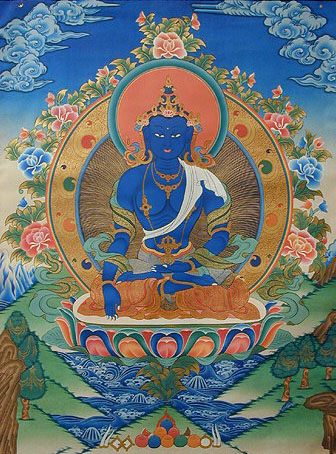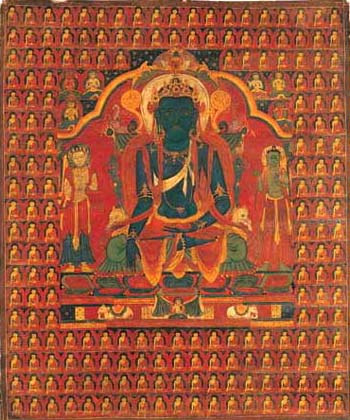AKSHOBHYA is a word in Sanskrit (India's classical language), meaning:
'immovable', 'unshakable' and 'imperturbable'
It is also the name of an important Buddhist deity:
The Akshobhya Buddha
Akshobhya is a principal transcendental Buddha in the Vajrayana school and
also a minor transcedental Buddha within the Sutra (i.e. texts) tradition
of Mahayana Buddhism. His Tibetan name is MI KYU PA or SANG RE.
Akshobhya arises in the eastern direction, on an elephant with lotus
and moon throne. His body colour is blue and his right hand in the
bhumisparsha mudra (hand gesture of touching the earth), representing
the enlightenment commitment by calling the earth to commemorate
Sakyamuni Buddha's victory over temptation by Mara (God of Delusion
and Death). Akshobhya's left hand placed palm upward in the lap performs
the mudra of meditation
Akshobhya rules over the element of water and personifies the skandha of form.
In some systems, he is associated with the skandha of consciousness.
His lotus throne, supported by the elephant, represents steadfastness and strength.
His symbol is the vajra, which denotes enlightenment, the indestructible,
adamantine nature of pure consciousness, or the essence of Reality.
In some traditions the vajra signifies the union of man and the Buddha;
one end of the vajra symbolizes the macrocosmic realm (the Buddha)
and the other end the microcosmic realm (man).
Tibet, 14th century, Thangka (gouache on cotton), 60 x 51cms
Occupying a central role in Vajrayana Buddhism, Akshobhya, by some accounts,
is Lord of the 2nd of the Five Buddha Families of tantra and found throughout all
4 tantra classifications most notably in the anuttarayoga class.
Akshobhya is also mentioned in several Mahayana sutras, the Vimalakirti Nirdesa
being the most famous. It was in Abhirati, the pureland of Akshobhya, attainable
only by 8th level bodhisattvas, where the famous Tibetan yogi Milarepa and the
scholar Sakya Pandita are said to have obtained complete buddhahood.
Akshobhya Buddha originates from the blue mantra "Hum" and reigns over the
eastern paradise (Abhirati). It is believed that whoever is reborn there can never
fall back to a lower level of consciousness, thus all believers should seek to fulfill
the promise kept by Akshobhya. Akshobhya's bija is Hum and his mantra is:
Om Akshobhya Hum
He resides in the eastern quarter of a mandala, surrounded by numerous forms
of Green and White Tara. His consort is Lochana, and they represent the Tathagata
family, space and all encompassing wisdom.
Seated Buddha Akshobhya, 9th -10th century, Tibet, Gilt copper; 57.8 cms
The monk Akshobhya took a vow before the Buddha, who reigned over
Abhirati, never to feel disgust or anger towards any living being. In carrying
out this vow, he showed himself "immovable" and after striving endlessly long
he became Buddha Akshobhya and the ruler of the Abhirati paradise.

